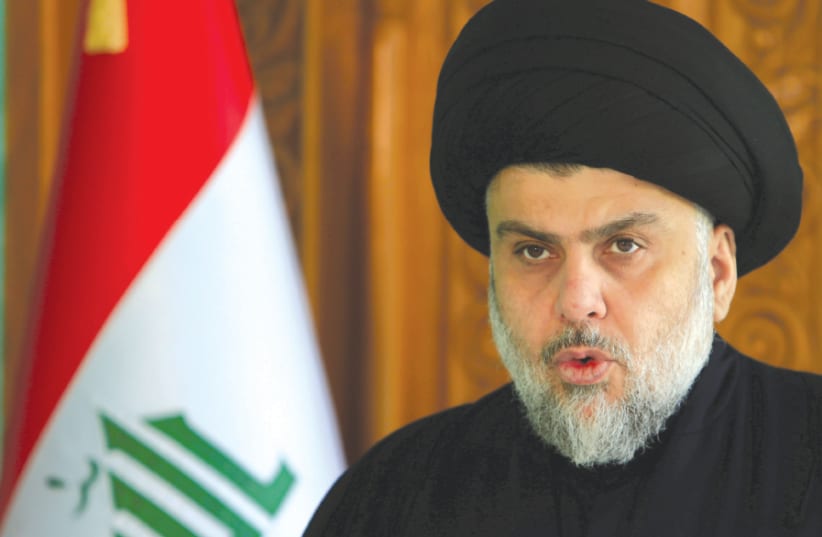The turn of events has been in the works for a month. Sadr, leader of Iraq’s largest party, has been prevaricating for months. His party charged to victory in the 2018 elections with 54 seats in parliament. The next largest party, the Fatah Alliance which is run by Badr Organization’s Hadi al-Amiri and pro-Iranian, got 48 seats. Sadr at the time was thought to be pivoting away from Iran and toward a more nationalist Iraqi stance. This was the thought among US policy-makers who had encouraged Saudi Arabia to outreach to the Iraqi. Sadr was a volatile force, once a leader of anti-US protests after 2003, he had been to Iran before in exile and had been threatened by pro-Iranian groups in the past. He had led massive social justice protests in the Green Zone in 2016. Washington hoped in 2018 he would be their new hope Iraq after Haider al-Abadi had proved to be more pro-Iranian than analysts thought. Abadi had enshrined the Popular Mobilization Units, Iraqi-based militias, as part of the security forces.
When protests broke out in Iraq in October 2019 the government reacted with force. Prime Minister Adel Abdul-Mahdi, weak and ineffectual, let the local security apparatus decide how to handle them. A mix of riot police and militias linked to Iran and the PMU went into break the protests. But the protesters proved themselves stronger than the government thought. They sacked the headquarters of numerous militia parties, such as Asaib Ahl al-Haq, Kataib Hezbolla, Harakat Hezbollah al-Nujaba and Badr. They attacked the Iranian consulates in Najaf and Karbala, holy Shi’ite cities.
The security forced backed off and the protesters came to control areas of some major southern Iraqi cities such as Tahrir Square in Baghdad. The government crackdown and sniper fire from various militias, as well as kidnappings of protesters, led to the deaths of 400 protesters by November. In Nasiriyah a security force from the ERD gunned down dozens of protesters leading to the resignation of Prime Minister Abdul-Mahdi.
Throughout the months of October and November Sadr appeared to support the masses. He sent his Saraya al-Salam activists to protect the protesters wearing blue helmets. Other major voices in Iraq appeared to sympathize with the protesters, including President Barham Salih and Ayatollah Ali Sistani. By late December Salih had threatened to resign rather than appoint a Prime Minister that the protesters did not agree with.
Iran changed things in Iraq by ordering Iraqi militia allies, particularly Kataib Hezbollah, to fire rockets at bases housing US forces. This was part of a wider campaign of Iran’s attempt to challenge the US in 2019, which included attacking oil tankers, using drones against Saudi Arabia and downing a US drone in the Gulf of Oman. In Iraq the errant rocket fire angered the Pentagon and State Department which went public in early December with accusations Iran was behind it. The US then blacklisted Asaib Ahl al-Haq leader Qais Khazali for involvement in suppressing protesters. On December 27 rockets fired at K-1 base killed a US contractor. The US response was harsh, killing dozens of Kataib Hezbollah members at five locations on December 29.
Sadr, who had been in Iran in September to meet Ayatollah Khamenei and IRGC general Qasem Soleimani, now was pressured to side with pro-Iranian elements in the dispute with the US. He said he was ready to work with PMU and Amiri to get the Americans to leave Iraq on December 30.
Caught up in US-Iran tensions the turning of Sadr didn’t strike some as initially important. After all, on December 20 the theory had been that Sadr, because he supported the protesters, could bring “calm” to Iraq. Sadr was hesitant to send his supporters to the protests at the US embassy on December 31. It didn’t matter because the US was already tracking the movements of Kataib Hezbollah leader Abu Mahdi al-Muhandis and Soleimani. When Soleimani boarded a flight for Baghdad on the night of January 2 to meet Muhandis to strategize against the US, a Us drone fired rockets at the men.
Sadr still waited to see which way the wind was blowing. On January 8 Iran fired ballistic missiles at a base housing US forces. Sadr then said that he supported a million-person march in Iraq to end the US presence. From January 16 to January 24 Sadr’s people set about organizing the protest. Buses would bring the hundreds of thousands from areas his supporters live in southern Iraq. Badr’s Amiri would help with security. The government, whose president was in Davos and whose Prime Minister had resigned, would enable the protest in a way it had never enabled the other protesters who had opposed Iran’s influence and called for reform.
Here Sadr hijacked the months of protests he had been angling to gain support from. After his hundreds of thousands came to Baghdad they marched peacefully and went home. On the night of January 24 new orders were released to riot police and militias. All the protesters were to go home, which meant dismantling the tents and facilities that had grown up in places like Tahrir square. On Saturday clashes throughout the day targeted the protesters. Live ammunition and tear gas was used. Sadr appeared to no longer back the Iraqi youth who had already sacrificed up to 700 killed and 20,000 injured since October.
Images on Saturday show protesters tents and medical facilities burned. They also show police brutality and snipers. Protesters have vowed to remain, fighting with security forces on Wathba street and at Sinak bridge. But the security forces appear to have coordinated some efforts from Baghdad to Basra, to try to end months of protest. The protesters are now in their seventeenth week. After Sadr’s abandonment and with an empowered Iran that wants to make an example of them to punish them as part of anger against the US, it is unclear if they will make it the eighteenth week.
